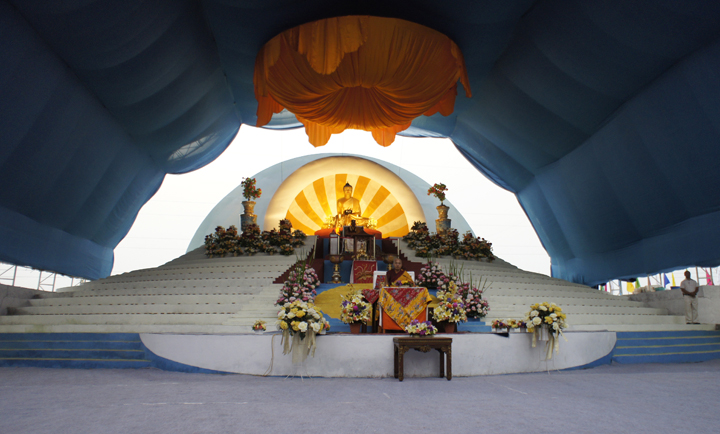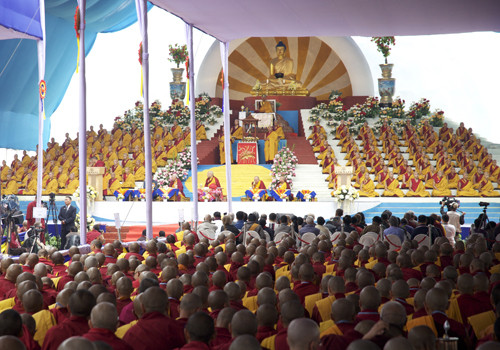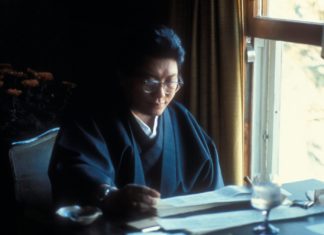
Photograph by James Gritz
James Gritz reports, December 11, 2010:
We are here in Bodhgaya working from dawn to late at night on the film of the Karmapa and the Kagyu Monlam. One by one we are all getting colds and dealing with the dust in the air of Bodhgaya. The first two days were the 900 celebration of the First Karmapa Dusum Khyenpa. The day before yesterday His Holiness and everyone went to Cool Grove and the Mahakala cave about 30 minutes in the country outside of Bodhgaya where he performed a chod offering. Later at the cave itself Tenga Rinpoche arrived and gave an excellent talk on the history of this Vajrayana site, rich in the lore of many accomplished Mahasiddhas. We will try and transcribe some of that talk and send it with photos later.
In Karmapa’s teaching on the Lamp of Atisha during the first two days Karmapa has barely touched on the text itself. He has been very forceful saying again that practice in the monasteries and practice on our cushions with all the ritual objects of Tibetan Buddhist practice, our drums and bells, our special bone horns and our precious malas is not good enough, and is not the main point. He says that in these times we need to be active in the world, manifesting our compassionate activity every day. With limitless beings suffering we need to have limitless compassion and always be thinking of those we see suffering, doing what we can to help. He refers to the suffering of all beings and not just humans. He is telling many stories about the suffering we have caused animals, from chickens in cages, animals being led to slaughter so that we can eat their meat, dogs suffering on the streets, etc. He keeps repeating how much suffering we have caused other beings from our actions, or even the suffering we cause indirectly from being the recipients of the food that causes others to suffer. He says if the animals of the world could take human beings to court there is no doubt they would win the lawsuit. -James Gritz
Teachings from the 17th Karmapa, Seattle 2008
The following transcript from the DVD, The Journey Begins – Wisdom of Enlightened Mind teachings from the Karmapa’s historic first visit to the United States, May 31 – June 1, 2008.
Sometimes I think of the world as being as a great theater – a great theater that was made especially for one self. When I see stars and planets at the sky at night, the sun in the day, these are like the stage lights of the theater, the beautiful features of the world such as rivers and mountains are like the stage props – ornaments and paintings in the theater.
 Within this theater we have the complete freedom to enact any play we want to perform. If we would like to view an excellent and inspiring and beautiful play, we can make this play happen in this theater. Similarly if we wish to view an extremely sad and disturbing tragegy, then all the conditions are present for us to perform this kind of play as well.
Within this theater we have the complete freedom to enact any play we want to perform. If we would like to view an excellent and inspiring and beautiful play, we can make this play happen in this theater. Similarly if we wish to view an extremely sad and disturbing tragegy, then all the conditions are present for us to perform this kind of play as well.
This theater is a very open space that has been made for us and our choices. It is important for us the actors in this powerful hall to recognize the excellent opportunity we have. We also must take good care of the theater as well.
These days humans have a habit of focusing solely on obtaining very small forms of happiness solely for themselves. When they fail to obtain these small amounts of happiness they then destroy the happiness and well being of others and of the world. This narrow approach is beset by pride and ego clinging and an unhealthy amount of attention to the concern of one self alone.
When we so solely disregard the welfare of others, we begin to seriously endanger the very theater in which the show of our own birth and death our own joys and sorrows is performed, we subject our world to the risk that it will disappear. When this happens it is very sad.
We can all see clearly that our own bodies are an indispensable basis for our own individual happiness. No matter what we want to do with our lives, no matter what future we see ahead of ourselves we need our basic health in order to make that possible, if that is true, then it is also true that the world itself is the indispensable ground for the well-being and indeed the survival of all beings. Therefore the continuity of the world is the responsibility of everyone.
The Stage is set
by Naomi Levine
December 8th, 2010 Tergar Monastery, opening ceremony of Karmapa 900 — the 900 year celebration of the Kagyu Lineage
The stage is set like a celestial palace with a gigantic gold-painted Buddha enclosed in a semi-circular niche emanating a sunburst of golden rays. A magnificent gold parasol hangs suspended from a pale blue ceiling in the centre of the dome. First in the line of vision is the Buddha. Under it is a large replica of the first Karmapa, Dusum Khyenpa. Following the line downwards is the antique statue of Dusum Khyenpa, which is said to have spoken when it was in Tibet. On either side of this precious image are two huge urns with flowers and below them are two oversized butter lamps. Two monks on either side sit like guards in vigilant zen-like repose. Filling the stage in raked formation are the assembly of monks wearing gold cloaks, poised like nesting birds.
Above the stage is a golden walk-way shaped like a sun disc. Sitting in direct formation with his predecessor is the 17th Karmapa with his precious Lamas, Jamgon Kongtrul Rinpoche and Gyaltsap Rinpoche. The Prime Minister of the Dalai Lama’s government in exile, Samdhong Rinpoche, sits on the right. A red carpet strewn with marigold and lotus petals leads to the heart of the mandala.
This is the stage for the opening ceremony for the Karmapa 900 celebrations to honour Dusum Khyenpa, the first Karmapa, born in 1110. The seventeenth in the lineage has the great gift of theatricality, religious performance heightened by aesthetic perfection to inspire veneration and instill a sense of awe. When the procession with the statue of Dusum Khyenpa entered the arena held in a wooden palanquin by elaborately costumed monks, there was an audible gasp and the kind of silence that springs from the collective unconscious in rare moments shared by religion and art.
The high point for some may have been the lavish tribute paid to the Karmapa Lineage by the Kalon Tripa, Samdhong Rinpoche; or the congratulatory message from the Dalai Lama. But for me and many others, it came from the space beyond words when a doha in Sanskrit composed by the Indian lineage forefather, Tilopa, was put to the music of flute, tabla and sitar by South Indian musicians. The sound dropped naturally into the space of that spectacular mandala, creating an exquisite fusion of India and Tibet. It felt like the dharma was coming home.
















